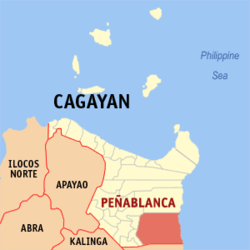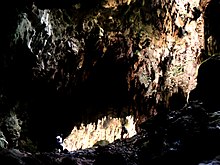Peñablanca
Peñablanca | |
|---|---|
| Municipality of Peñablanca | |
 Pinacanauan River | |
 Map of Cagayan with Peñablanca highlighted | |
Location within the Philippines | |
| Coordinates: 17°37′33″N 121°47′07″E / 17.6258°N 121.7853°E | |
| Country | Philippines |
| Region | Cagayan Valley |
| Province | Cagayan |
| District | 3rd district |
| Barangays | 24 (see Barangays) |
| Government | |
| • Type | Sangguniang Bayan |
| • Mayor | Washington M. Taguinod |
| • Vice Mayor | Marilyn J. Taguinod |
| • Representative | Joseph L. Lara |
| • Electorate | 29,523 voters (2022) |
| Area | |
• Total | 1,193.20 km2 (460.70 sq mi) |
| Elevation | 58 m (190 ft) |
| Highest elevation | 301 m (988 ft) |
| Lowest elevation | 14 m (46 ft) |
| Population (2020 census)[3] | |
• Total | 50,300 |
| • Density | 42/km2 (110/sq mi) |
| • Households | 11,595 |
| Economy | |
| • Income class | 1st municipal income class |
| • Poverty incidence | 10.18 |
| • Revenue | ₱ 357.3 million (2020) |
| • Assets | ₱ 539.5 million (2020) |
| • Expenditure | ₱ 299.9 million (2020) |
| • Liabilities | ₱ 16 million (2020) |
| Service provider | |
| • Electricity | Cagayan 1 Electric Cooperative (CAGELCO 1) |
| Time zone | UTC+8 (PST) |
| ZIP code | 3502 |
| PSGC | |
| IDD : area code | +63 (0)78 |
| Native languages | Ibanag Ilocano Itawis Atta Tagalog |
| Website | www |
Peñablanca, officially the Municipality of Peñablanca (Ibanag: Ili nat Peñablanca; Ilocano: Ili ti Peñablanca; Tagalog: Bayan ng Peñablanca), is a municipality in the province of Cagayan, Philippines. According to the 2020 census, it has a population of 50,300 people.[3]
Peñablanca is home to the charcoal-drawn Peñablanca petrographs. Both the Peñablanca petrographs and the Callao Limestone Formation are included as tentative sites of the Philippines for future inclusion in the UNESCO World Heritage List.[5] The Callao Limestone Formation has at least 93 archaeological sites that yielded stone tools of Paleolithic industry and bones and shells of animals still living in the vicinity.
History
[edit]Named after its prominent white rock formations, Peñablanca was formerly a barrio of Tuguegarao named Bubug. However, it also went by other names such as Alimannao, which was said to have been derived from a German rancher named Otto Weber, who, when one of his servants was asked who owned the cows in the area, responded in Itawis: cua na Aliman yao (they belong to the German). Another name for the place was camasi, from the native word for tomato, which abounded in the area.[6] Both Alimannao and Camasi are now names of barrios in the municipality.
Peñablanca was made a separate municipality by the Spaniards on November 20, 1886. Its first inhabitants were Kalingas (unbaptized Irrayas) and Negritos.[7]
Geography
[edit]Situated 6 kilometres (3.7 mi) east of the provincial capital Tuguegarao and 475 kilometres (295 mi) north of Manila, the municipality is home to the Peñablanca Protected Landscape and Seascape which contains the Callao Cave (part of the Callao Limestone Formation Paleolithic Archaeological Site), one of the province's well-known landmarks and tourist spots.
Barangays
[edit]Peñablanca is divided into 24 barangays. Each barangay consists of puroks while some have sitios.
- Aggugaddan
- Alimanao
- Baliuag
- Bical
- Bugatay
- Buyun
- Cabasan
- Cabbo
- Callao
- Camasi
- Centro (Poblacion)
- Dodan
- Lapi
- Malibabag
- Mangga
- Minanga
- Nabbabalayan
- Nanguilattan
- Nannarian
- Parabba
- Patagueleg
- Quibal
- San Roque (Litto)
- Sisim
Climate
[edit]| Climate data for Peñablanca, Cagayan | |||||||||||||
|---|---|---|---|---|---|---|---|---|---|---|---|---|---|
| Month | Jan | Feb | Mar | Apr | May | Jun | Jul | Aug | Sep | Oct | Nov | Dec | Year |
| Mean daily maximum °C (°F) | 25 (77) |
26 (79) |
28 (82) |
31 (88) |
31 (88) |
31 (88) |
30 (86) |
30 (86) |
30 (86) |
28 (82) |
27 (81) |
25 (77) |
29 (83) |
| Mean daily minimum °C (°F) | 21 (70) |
21 (70) |
22 (72) |
23 (73) |
24 (75) |
24 (75) |
24 (75) |
24 (75) |
24 (75) |
23 (73) |
23 (73) |
22 (72) |
23 (73) |
| Average precipitation mm (inches) | 155 (6.1) |
113 (4.4) |
89 (3.5) |
58 (2.3) |
127 (5.0) |
131 (5.2) |
154 (6.1) |
184 (7.2) |
151 (5.9) |
247 (9.7) |
221 (8.7) |
292 (11.5) |
1,922 (75.6) |
| Average rainy days | 19.6 | 14.8 | 13.4 | 12.0 | 19.4 | 19.8 | 23.0 | 25.0 | 23.0 | 19.4 | 19.1 | 21.6 | 230.1 |
| Source: Meteoblue[8] | |||||||||||||
Demographics
[edit]| Year | Pop. | ±% p.a. |
|---|---|---|
| 1903 | 4,969 | — |
| 1918 | 6,478 | +1.78% |
| 1939 | 8,864 | +1.50% |
| 1948 | 8,799 | −0.08% |
| 1960 | 13,119 | +3.38% |
| 1970 | 18,218 | +3.33% |
| 1975 | 21,638 | +3.51% |
| 1980 | 24,888 | +2.84% |
| 1990 | 30,527 | +2.06% |
| 1995 | 33,190 | +1.58% |
| 2000 | 37,872 | +2.87% |
| 2007 | 40,336 | +0.87% |
| 2010 | 42,736 | +2.13% |
| 2015 | 48,584 | +2.47% |
| 2020 | 50,300 | +0.68% |
| Source: Philippine Statistics Authority[9][10][11][12] | ||
In the 2020 census, the population of Peñablanca, Cagayan, was 50,300 people,[3] with a density of 42 inhabitants per square kilometre or 110 inhabitants per square mile.
Economy
[edit]
Poverty incidence of Peñablanca
5
10
15
20
25
30
2006
24.50 2009
18.17 2012
20.06 2015
12.62 2018
27.72 2021
10.18 Source: Philippine Statistics Authority[13][14][15][16][17][18][19][20] |
Government
[edit]Local government
[edit]Peñablanca, belonging to the third legislative district of the province of Cagayan, is governed by a mayor designated as its local chief executive and by a municipal council as its legislative body in accordance with the Local Government Code. The mayor, vice mayor, and the councilors are elected directly by the people through an election which is being held every three years.
Elected officials
[edit]| Position | Name |
|---|---|
| Congressman | Joseph L. Lara |
| Mayor | Washington M. Taguinod |
| Vice-Mayor | Marilyn J. Taguinod |
| Councilors | Ma. Katrina T. Carag |
| Rodney D. Mora | |
| Janice L. Tungcul-Beleno | |
| Pauline Tatiana C. Dela Cruz | |
| Elisa C. Arugay | |
| Pedro Q. Alan | |
| Juan H. Lingan Jr. | |
| Eutiguio A. Calagui |
Education
[edit]The Schools Division of Cagayan governs the town's public education system.[22] The division office is a field office of the DepEd in Cagayan Valley region.[23] The office governs the public and private elementary and public and private high schools throughout the municipality.
Media
[edit]- 94.9 MHz FMR Cagayan (Philippine Collective Media Corporation)
References
[edit]- ^ Municipality of Peñablanca | (DILG)
- ^ "2015 Census of Population, Report No. 3 – Population, Land Area, and Population Density" (PDF). Philippine Statistics Authority. Quezon City, Philippines. August 2016. ISSN 0117-1453. Archived (PDF) from the original on May 25, 2021. Retrieved July 16, 2021.
- ^ a b c Census of Population (2020). "Region II (Cagayan Valley)". Total Population by Province, City, Municipality and Barangay. Philippine Statistics Authority. Retrieved July 8, 2021.
- ^ "PSA Releases the 2021 City and Municipal Level Poverty Estimates". Philippine Statistics Authority. April 2, 2024. Retrieved April 28, 2024.
- ^ "Petroglyphs and Petrographs of the Philippines". whc.unesco.org. UNESCO World Heritage Centre. Retrieved March 23, 2018.
- ^ de Rivera Castillet, Ed. Cagayan Province and her People. Community Publishers.
- ^ Salgado, Pedro. "Other Missions in Cagayan Province". Cagayan Valley and Easter Cordillera: 1581-1898, Volume I. Rex Publishing. pp. 360–361.
- ^ "Peñablanca, Cagayan: Average Temperatures and Rainfall". Meteoblue. Retrieved December 15, 2018.
- ^ Census of Population (2015). "Region II (Cagayan Valley)". Total Population by Province, City, Municipality and Barangay. Philippine Statistics Authority. Retrieved June 20, 2016.
- ^ Census of Population and Housing (2010). "Region II (Cagayan Valley)" (PDF). Total Population by Province, City, Municipality and Barangay. National Statistics Office. Retrieved June 29, 2016.
- ^ Censuses of Population (1903–2007). "Region II (Cagayan Valley)". Table 1. Population Enumerated in Various Censuses by Province/Highly Urbanized City: 1903 to 2007. National Statistics Office.
- ^ "Province of Cagayan". Municipality Population Data. Local Water Utilities Administration Research Division. Retrieved December 17, 2016.
- ^ "Poverty incidence (PI):". Philippine Statistics Authority. Retrieved December 28, 2020.
- ^ "Estimation of Local Poverty in the Philippines" (PDF). Philippine Statistics Authority. November 29, 2005.
- ^ "2003 City and Municipal Level Poverty Estimates" (PDF). Philippine Statistics Authority. March 23, 2009.
- ^ "City and Municipal Level Poverty Estimates; 2006 and 2009" (PDF). Philippine Statistics Authority. August 3, 2012.
- ^ "2012 Municipal and City Level Poverty Estimates" (PDF). Philippine Statistics Authority. May 31, 2016.
- ^ "Municipal and City Level Small Area Poverty Estimates; 2009, 2012 and 2015". Philippine Statistics Authority. July 10, 2019.
- ^ "PSA Releases the 2018 Municipal and City Level Poverty Estimates". Philippine Statistics Authority. December 15, 2021. Retrieved January 22, 2022.
- ^ "PSA Releases the 2021 City and Municipal Level Poverty Estimates". Philippine Statistics Authority. April 2, 2024. Retrieved April 28, 2024.
- ^ "2019 National and Local Elections" (PDF). Commission on Elections. Retrieved March 10, 2022.
- ^ "History of DepED SDO Cagayan". DepED SDO Cagayan | Official Website of DepED SDO Cagayan. Retrieved March 13, 2022.
- ^ "DEPED REGIONAL OFFICE NO. 02". DepED RO2 | The official website of DepED Regional Office No. 02.



